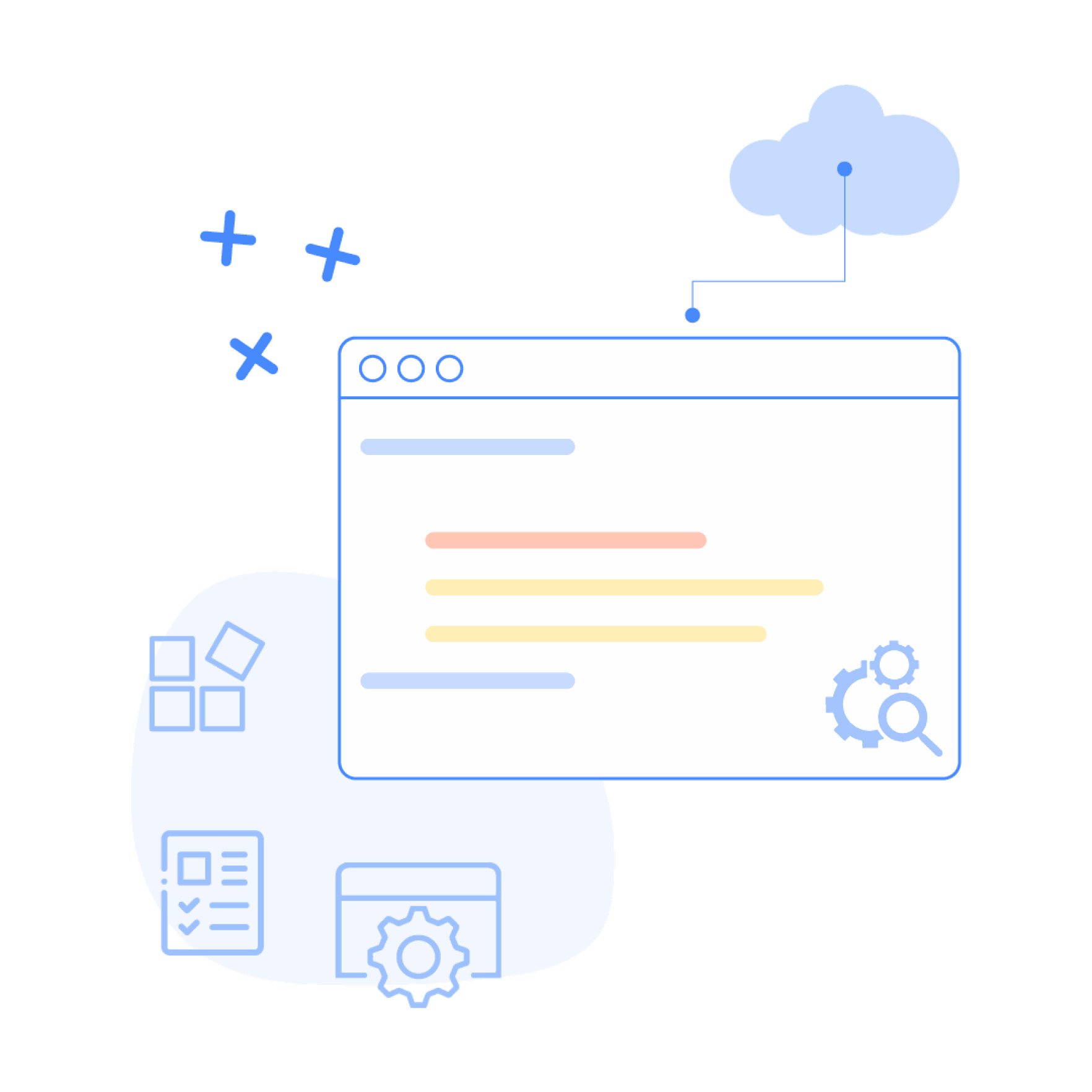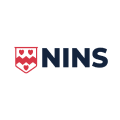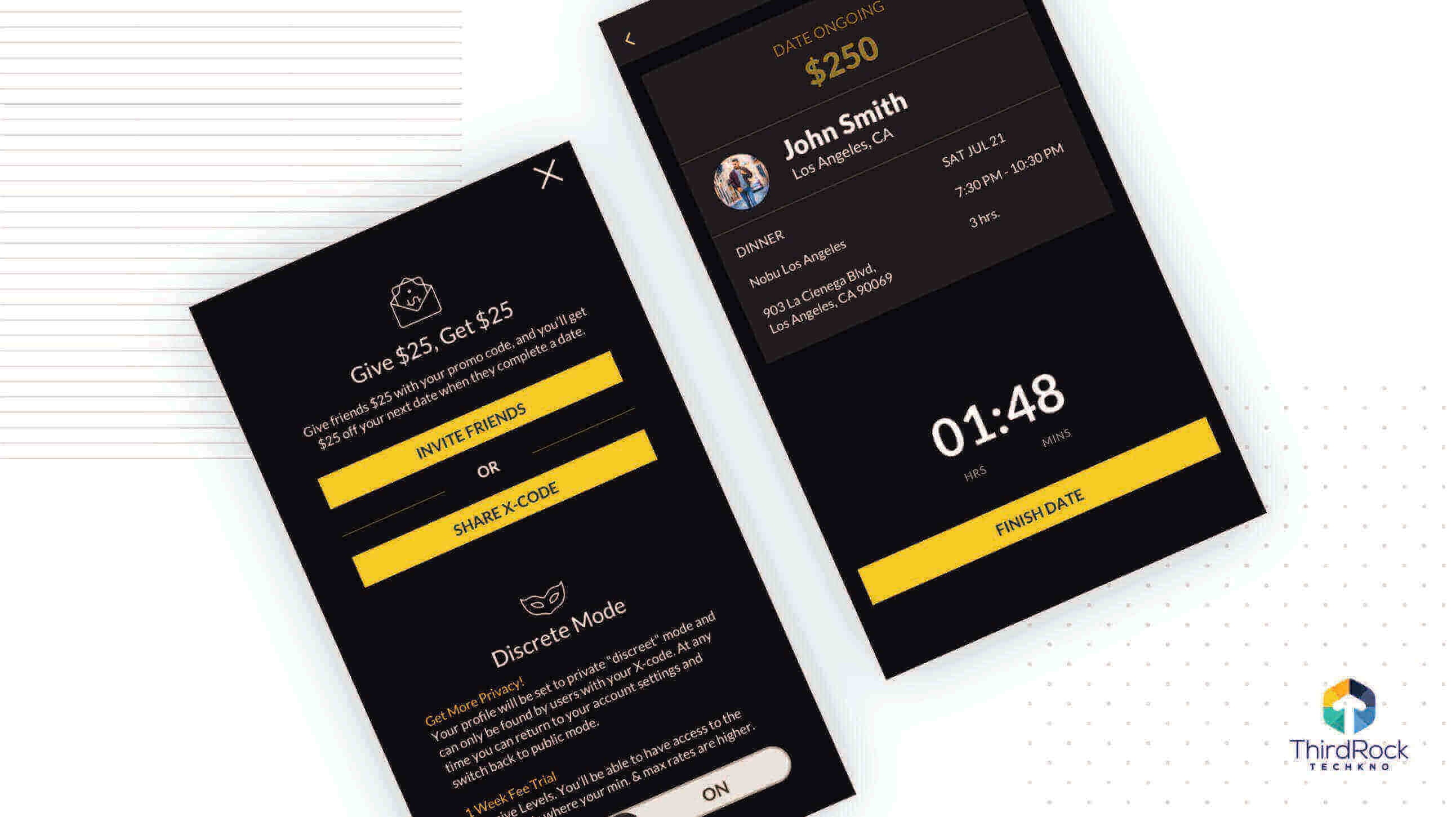

Our React Native Services
- 1. Cross platform app development
- 2. Universal app development
- 3. UI/UX update app development
- 4. Architecture change app development
- 5. Custom NPM package development
- 6. Maintenance and Update app development
Why Choose Us As Your React Native Development Company
Experienced Developers
Our seasoned React developers have the expertise to build secure, creative and highly-interactive mobile applications. Whether you are a startup or an SME, our experts will get the job done.

Trusted Delivery Methods
We employ the agile methodology to keep you in the loop. Our company is known to deliver quality React Native app development services that meet your business goals, timeline, and budget.
Competitive Rates
We offer the most competitive rates on the market. Our personalized React Native app development services meet different budget needs of our clients from across the globe.
Transparent Work Approach
We ensure complete project visibility right from the time you approach us with your needs. We use email, phone, Skype, Slack and other mediums for regular communication with you.
Customer Satisfaction
Our designers, developers, quality analysts, and a project manager – all strive for customer satisfaction. We deliver React Native app development services that align with our clients’ needs.
Client Testimonials
Our WORK speaks louder than our WORD. Find out how we helped clients overcome challenges and succeed.

Smoovr
Very good communication at all stages. Always prompt to reply. Excellent quality of work. The team at Third Rock Techkno was communicative, responsive, and accommodating as they produced high-quality work.
Jonathan Wood, Smoovr
Ontime
It was a pleasure working with the TRT team. Prior to contracting this group, I had a system created that was absolutely terrible and poorly developed. I also worked with a few freelancers that couldnt cut it either. TRT was actually able to execute on our concept and have built a truly solid system for our company.

Karl Pierre, Ontime
Main Features of React Native
Speed & Performance
React framework uses unique techniques to economize DOM operations required to update the UI. React 15.4.0. It also introduced a new performance timeline feature which allows the developers to see exactly when the components get updated, mounted and unmounted.
Component-Based
React is a component-based framework. With each component designed with specific logic, we can create a user interface of the web application. The logic is written in JavaScript instead of templates, so developers can easily pass the data throughout the application and keep the state out of the DOM.
Server-Side Communication
The library of React Native empowers developers by giving them lifecycle hooks to enable the server requests. This feature makes it easy to understand the mechanism of XHR requests and easily updates the library to use them.
Asynchronous Functions
One of the significant reasons for the immense use of React Native app development is the asynchronous function and generators offered by ES6.
Recent React Native Development Blogs

10 Most Popular Cross-platform Mobile Development Framework of 2024
Developers face numerous challenges, including the need to build apps that work seamlessly across multiple platforms, each with its own programming language and development environment. This is where cross-platform app development frameworks come into play, offering a approach to creating apps that provide a consistent experience on both Android and iOS devices. Developing a cross platform app let your product reach a larger audience in a cost-effective manner. Our Co-Founder Krunal Shah also added:- “Cross-platform app development frameworks are game-changers in this regard, enabling developers to build applications that deliver a uniform experience on both Android and iOS devices. This approach not only enhances efficiency but also ensures that our products reach a wider audience, making it an essential strategy for businesses aiming to grow in this fast-moving digital world.” The demand for cross-platform app development frameworks has reached a new height. The prime reason behind this increased demand is that cross-platform apps have a wider reach than native apps, which allows businesses to reach a wide number of people, making it a ‘one-of-a-kind technology.’ There were 3.55 million mobile apps available on the Google Play Store and 1.6 million apps on the App Store in the third quarter of 2023, with Android and iOS together now accounting for 99% of the worldwide mobile operating system market. In this blog, we'll dive into the 10 most popular cross-platform mobile development frameworks of 2024, exploring their benefits, key features, and the unique advantages they offer to developers. What is a Cross-Platform App Development Framework? A cross-platform app development framework is a software toolkit that enables developers to create mobile applications that run on multiple mobile operating systems from a single codebase. These frameworks simplify the app development process by providing a unified programming environment, reducing the need for separate development projects for each platform. By leveraging these frameworks, developers can significantly cut down on development time and costs while ensuring their apps can reach a wider audience. 10 Best Cross-Platform App Development Frameworks Here's a closer look at the 10 best cross-platform app development frameworks that will provide you the best efficiency 1. Flutter Native Apps in Record Time Developed by Google, Flutter has quickly risen to prominence for its ability to create visually appealing and highly performant mobile apps from a single codebase. It uses Dart as its programming language, which is optimized for fast, on-the-fly compilation to native code. This allows developers to achieve smooth animations and transitions that run at 60fps, which is essential for creating a responsive user interface.. Also read: Why Flutter Is the Best Platform to Make Hybrid Apps? Flutter cross-platform app framework develops apps that can run effectively on multiple platforms. Some of the main Key Features of this open-source cross platform app framework are: Key Features: * Hot reload allows developers to see changes in real-time without restarting the app. * A rich set of widgets for quick and customizable UI development. * A supportive community and extensive documentation. Target Platforms: Android, iOS, Web, Desktop Pros and Cons: * Pro: Offers a consistent UI and business logic across all platforms. * Con: The app size might be larger compared to other frameworks, which could be a downside for simple applications. Example Apps: Applications like Google Ads and Alibaba are built with Flutter, demonstrating its robustness. Flutter's architecture is designed around widgets, which are the basic building blocks of a Flutter app's user interface. This approach encourages a modular and reusable codebase, facilitating the rapid development of complex UIs. However, the relatively large size of apps built with Flutter can be a drawback, particularly for simple apps where minimal download time and storage space are priorities. Did you know:- Flutter is the most popular cross platform mobile framework in the world at 46%. According to the reports from statista. 2. React Native Is a Star in Itself When discussing the most popular cross-platform mobile development frameworks, it is hard to not include React Native in that list. React Native is extensively used for both iOS and Android as it is a well-known cross-platform development entity. Created by Facebook in 2015, it's no shock that its developer’s community is growing by leaps and bounds. React Native combines the best aspects of native development with React, a best-in-class JavaScript library for building user interfaces. It allows developers to build mobile apps that feel truly native without compromising on the development speed and efficiency that comes with using JavaScript. Despite being based on JavaScript React Native does not use HTML technology or WebView or CSS. Instead of them, components of the platform consist of CSS-like polyfills and JSX. In addition to this, there is no DOM API in React Native. The biggest USP on this cross-platform app is that it combines the best features of ReactJS and JavaScript. Moreover, the developers have the luxury of creating some parts using Java, Swift or Objective-C. Key Features: * Live reloading for real-time updates during development. * Strong performance in mobile environments, closely mimicking native app behavior. * Direct access to native components allows for a seamless user experience. * Target Platforms: Android, iOS Pros and Cons: * Pro: Enables developers to write code once and deploy on both major platforms, saving time and resources. * Con: Complex applications might still require native code, which can complicate development. Example Apps: Major apps like Facebook and Instagram showcase its capabilities. One of React Native’s strengths is its community, which is among the largest for any cross-platform framework. This community support translates to a wealth of tutorials, forums, and third-party tools that can help solve virtually any development challenge. However, complex apps might still require native code, which can steepen the learning curve for developers unfamiliar with native mobile development. Read More: Flutter vs React Native: What to choose 3. Ionic is ‘Iconic’ in Every Sense Ionic framework is by far the most popular cross-platform mobile development framework which is based on AngularJS. It is an open-source cross-platform app development framework which was made first in 2013 by Adam Bradley, Max Lynch and Ben Sperry. The main components of Ionic’s main version were Apache Cordova and AngularJS. Due to the Apache Cordova principles, the mobile applications that are created with Ionic framework are hybrid HTML apps. The USP of these apps is that it runs in a special shell on your smartphone devices. For example, the applications run on WebView for Android and UIWebView for iOS. Ionic framework is designed to enable web developers to build mobile and progressive web apps (PWAs) using familiar web technologies such as HTML, CSS, and JavaScript. It’s especially suited for creating applications that do not require complex animations or high performance, making it a good choice for small businesses and simple applications. Key Features * A rich library of front-end components. * Integrates with Angular, React, and Vue. * Capacitor provides native access to device features. Target Platforms: Android, iOS, Web Pros and Cons: * Pro: Easy to learn for developers familiar with web technologies . * Con: Webview for rendering might not match the performance of native apps. Example Apps: Sworkit is a great example of Ionic to create high performance quality mobile apps. Ionic's emphasis on web technologies makes it highly accessible to developers but can lead to performance limitations for more complex or demanding applications. Its integration with Angular, React, and Vue also makes it versatile and adaptable to different project requirements. Read More: React Native Vs Ionic: The Battle of Two Cross-Platform App Development 4. Cordova Your App, Every Device. Apache Cordova offers a way to build mobile applications using HTML5, CSS3, and JavaScript, with the ability to access device hardware features such as the GPS, camera, and accelerometer via its extensive plugin system. Brief Overview: Apache Cordova (formerly PhoneGap) is a mobile application development framework that allows developers to create apps using CSS3, HTML5, and JavaScript instead of relying on platform-specific APIs. Key Features * Access to native device APIs. * Large plugin library. * Supports development for multiple platforms with a single codebase. Target Platforms: Android, iOS, Windows Phone Pros and Cons * Pro: Leverages web technologies for mobile app development. * Con: Performance can be slower compared to native apps. Example Apps: Cp Jobsite and Estella Furs are two examples for mobile app development, built on Cordova. While Cordova enables developers to create mobile apps using web technologies, it can sometimes result in lower performance compared to native apps, especially for graphically intensive applications. This makes it more suited for content-driven apps rather than performance-critical games or applications. Read More: Best Node.js Frameworks For Efficient Web Development 5. Xamarin Is Distinct Yet Useful Xamarin uses C# and .NET to create apps that can run on nearly any platform while sharing code across all of them. It's particularly strong in scenarios where business logic needs to be shared across web and mobile apps but with a native user interface on each platform. Xamarin allows the developers to use 90% of the code to build apps for different platforms. Key Features * Native performance across all platforms, utilizing platform-specific hardware acceleration. * Full .NET framework support enhances development capabilities. * Backed by Microsoft, ensuring stability and continuous updates. Target Platforms: Android, iOS, Windows Pros and Cons * Pro: Shared codebase reduces development time and costs. * Con: Limited access to certain platform-specific features can be a drawback for some developers. Example Apps: Alaska Airlines are examples of Xamarin’s capability to deliver complex, reliable applications. Xamarin's approach to cross-platform development strikes a balance between development efficiency and native app performance. However, the framework can produce larger app sizes and may require platform-specific adjustments to achieve the desired performance and look. Did you know:- The original name of the platform was mono and it was called in 2011 also microsoft acquired Xamarin for between USD 400 to 500 million. Also read: Does Your Web Application Need A Front-End Framework? 6. NativeScript Is Rising Through the Ranks NativeScript allows developers to use JavaScript, Angular, Vue.js, or TypeScript to build native mobile applications. Unlike other frameworks that use web views, NativeScript apps use real native components, providing a high-performance user experience that is indistinguishable from apps built using native SDKs. NativeScript scores its place amongst the most popular cross-platform mobile development frameworks because of the convenience it provides developers who don’t need to install extra plugins for various other functions. Moreover, the platform is aptly suited to work on Write Once, Run Anytime (WORA) functionality, NativeScript is best fit for you. In addition, the developers can use the existing plugins as NativeScript has all native APIs. Key Features * Direct access to Android and iOS APIs. * Native UI without WebViews. * Rich ecosystem and plugins. Target Platforms: Android, iOS Pros and Cons * Pro: Offers native performance and UI. * Con: Steeper learning curve for developers new to Angular or Vue.js. Example Apps: Daily Nanny and Strudel NativeScript is particularly well-suited for developers who prefer to work with Angular or Vue.js. However, its community is smaller compared to frameworks like React Native or Flutter, which might affect the availability of resources and third-party plugins. 7. Unity Build Worlds, Play Anywhere Unity is a powerful engine for game development that also offers features for mobile app development. Its ability to create visually rich and interactive experiences makes it ideal for projects that require high-quality graphics, 3D modeling, and real-time animations. Its cross-platform compatibility, intuitive interface, and extensive resources make it an attractive choice for developers seeking to create visually stunning and interactive projects, pushing the boundaries of creativity and innovation across diverse fields. * Key Features: * High-quality 3D and 2D graphics. * Comprehensive asset store. * Strong support for AR and VR applications. Target Platforms: Android, iOS, Windows, Mac, Linux, game consoles Pros and Cons * Pro: Best in class for games and interactive applications. * Con: Overkill for simple or non-graphical apps; licensing costs. Example Apps: Pokémon GO and Monument Valley While Unity is an excellent choice for game development or apps with complex animations and graphics, it might be overkill for simpler applications. The learning curve can be steep for those not familiar with game development principles. Did you know:- While widely known for games like Fall Guys and Cuphead, Unity is used for diverse projects like architectural simulations, VR training experiences, and even medical visualizations. Also read: Native vs. Cross-Platform: How and What to Choose? 8. Qt Write Once, Design Everywhere Qt is a cross-platform C++ framework used for developing applications and graphical user interfaces (GUIs) that run on various hardware and software platforms. It's particularly well-suited for creating complex, high-performance applications that need to run on desktop, embedded, and mobile platforms. Key Features * Strong graphics support for UI and 3D applications. * Wide range of tools for development, testing, and deployment. * Supports embedded, desktop, and mobile applications. * Target Platforms: Android, iOS, Windows, Linux, embedded systems Pros and Cons * Pro: Powerful for complex applications and supports a wide range of platforms. * Con: C++ can be challenging for beginners and the license cost for commercial use. Example Apps: Autodesk Maya and Skype are one of the best example for Qt framework Qt’s comprehensive set of features and tools make it a powerful option for developers working on cross-platform applications, especially where performance and fluid user interfaces are critical. However, its licensing model and the complexity of C++ may be barriers for some developers. 9. Appcelerator Titanium for Easier Mobile App Development Appcelerator Titanium is an open-source cross-platform app development framework, first released in 2008. Its core features include device functionality, cross-platform API for accessing native UI and MVC-based framework alloy. Appcelerator Titanium uses JavaScript to create native apps across different platforms. It combines the flexibility of JavaScript with the power of native development, allowing for the creation of high-quality mobile applications. The developers can deploy data models easily through Appcelerator Titanium as it offers a schema-less database ArrowDB. It majorly focusses on streamlining the mobile app development process with the assistance of the native components. Key Features: * Alloy Framework: Titanium’s MVC framework Alloy allows developers to write less code and * Direct Access to Native APIs: Offers comprehensive access to native functionality * Integrated Mobile Backend Services (MBaaS): Appcelerator includes cloud services out of the box. Target Platforms: Android, iOS Pros and Cons: * Pro: Because it generates native UI components, the performance is generally superior to hybrid apps. * Con: The reliance on a proprietary platform means that developers must invest in learning the specifics of the framework. Example Apps: Several notable applications have been developed with Appcelerator Titanium, including Hyperloop and PlexusRx showcasing its capability to deliver professional, high-quality mobile applications. 10. Sencha Touch Is a Boon to Develop Large Business Apps The basic application of Sencha Touch is to accelerate hardware techniques. Moreover, if you are looking for inbuilt Cordova integration, Sencha Touch cross-platform app development framework is your best bet. Sencha Ext JS is designed for building data-intensive, cross-platform web and mobile applications using JavaScript. It offers a wide range of pre-built components and tools that make it particularly useful for enterprise-level applications. Key Features * Comes with over 140 pre-integrated and high-performing components, * Offers a powerful data package that supports complex data management and manipulation * Includes Sencha Architect, a visual app builder that simplifies the development process. Target Platforms: Web (primarily), with capabilities for mobile app development through wrappers or mobile-optimized views. Pros and Cons: * Pro: Extjs extensive component library and data management capabilities * Con: The learning curve can be steep due to its comprehensive nature. Example Apps: Sencha Ext JS is used by thousands of enterprises like Fidelity Investments and nationwide building society. Sencha Ext JS is a solid choice for enterprise developers who need to build complex, feature-rich applications. However, its steep learning curve and the cost of licenses can be significant considerations for individual developers or smaller teams. Did you know that:- Sencha, the company behind Ext JS, used to host an annual conference called SenchaCon. It brought together developers and IT professionals from around the globe to share insights, techniques, and innovations in web application development using Sencha technologies. Conclusion We hope the above-mentioned list of the most popular cross-platform mobile development frameworks was insightful and will play a pivotal role in redefining your mobile app development process. After reading about their descriptions and their salient features, it would make it easier for you to choose the best platform for your product. Choosing the right cross-platform app framework is important as it would be vital in increasing the user base of your product. Thus, look for an experienced cross-platform application development company to assist you in developing your next project. Frequently Asked Questions (FAQs) 1.What is a cross platform framework? A cross platform frameworks refers to a framework that is used by the developers to develop applications for multiple platforms and ensure compatibility for all. Some of the major advantages of this type of framework are faster delivery, single source code, hassle-free product maintenance and others. 2. Is .net framework cross platform? Yes, .Net is a cross platform app development framework and also it is open source, lets you use multiple languages, editors, and libraries to build such applications. 3.Is Angular a cross platform framework? Angular is a famous cross platform framework which just requires a JavaScript engine to be executed. This open source framework is written in TypeScript and offers the developers with a standard structure to build cross-platform applications. 4.Which framework can be used to develop cross platform applications? Some of the competitive cross platform application development frameworks are Flutter, React Native, Ionic, and Node.JS, to name a few. All these frameworks come with their own set of advantages to build cross platform applications such as inbuilt graphic engine, open-source cross platform app development solution, and wide developer’s community, to name a few. What service are you looking for? Choose us as per your convenience, time and Project!!! Hire Us

14 Crucial Android Development Tools for Making a Great App
Mobile applications have become an indispensable part of our lives, seamlessly integrating into our daily routines. Android, a renowned operating system, powers a staggering 71.94% of the global smartphone market (StatCounter, 2023), providing a vast platform for app developers to showcase their creativity and innovation. With over 2.8 million Android apps available on the Google Play Store (Android Developers, 2023), the demand for exceptional app experiences continues to grow exponentially. Creating an exceptional Android app requires a combination of technical expertise, design ingenuity, and the right tools to bring your vision to life. Choosing the appropriate development tools can streamline the process, enhance productivity by up to 20%, and ultimately contribute to crafting a remarkable app experience for users, leading to increased user engagement and app retention. Knowing how to choose the right tools for Android development can be tricky so we decided to list out some of the more important ones. 14 Best Android Development Tools The realm of Android development offers a diverse array of tools, each tailored to specific needs and skill levels. Here's a comprehensive overview of 14 essential tools that empower developers to create exceptional Android apps: Android Studio: The Ultimate IDE Android Studio stands as the cornerstone of Android development, serving as an integrated development environment (IDE) specifically designed for building Android apps. This official IDE from Google provides a comprehensive set of features, including a sophisticated code editor, debugging tools, and a visual layout editor, making it the go-to choice for both novice and experienced developers. Real-world example: Spotify, the popular music streaming service, utilizes Android Studio to develop and maintain its Android app. The IDE's powerful features and seamless integration with Google Play services have been instrumental in Spotify's success in the Android market. Pros: * Comprehensive set of features * Official IDE from Google * Active community support Cons: * Can be overwhelming for beginners * Limited debugging options for some devices * Some features may require additional plugins GameMaker Studio 2 For aspiring game developers, GameMaker Studio 2 emerges as a powerful platform to create engaging and interactive 2D games. Its drag-and-drop interface and event-based programming system simplify the development process, allowing users to focus on their creative vision without getting bogged down by complex coding. Real-world example: The popular mobile game "Alto's Odyssey" was created using GameMaker Studio 2. The tool's intuitive interface and robust features enabled the developers to bring their creative vision to life, resulting in a visually stunning and engaging game that has won numerous awards. Pros: * Easy-to-use drag-and-drop interface * Event-based programming for beginners * A large community of developers and tutorial Cons: * Limited for complex 3D games * Requires additional resources for advanced features * Limited support for some newer Android APIs Maybe read:- Top Android App Development Trends in 2021 Zoho Creator Zoho Creator presents a versatile app development platform that caters to a wide range of users, from business professionals to individuals with minimal programming expertise. Its intuitive drag-and-drop interface and pre-built templates enable users to swiftly build mobile apps without the need for extensive coding. Real-world example: Zoho Creator has been used to develop a variety of mobile apps, including a custom app for a real estate company to manage property listings and a mobile app for a non-profit organization to track volunteer hours and donations. Pros: * Intuitive drag-and-drop interface with pre-built templates. * Suitable for non-programmers and beginners. * Cloud-based platform for easy collaboration. Cons: * Limited customization options for advanced. * Not ideal for complex app development. * Limited integration with external development tools. Android Asset Studio Android Asset Studio plays a crucial role in app development by streamlining the creation of essential graphical elements, such as app icons, launcher icons, and various 9-patch images. Its user-friendly interface and comprehensive features make it an invaluable tool for crafting visually appealing and consistent app designs. Real-world example: The app development team for a popular fitness app called Nike Run Club utilized Android Asset Studio to create a consistent set of app icons and graphics that aligned with the app's overall branding and visual style. Pros: * Easy to use creates a consistent graphical element * A wide range of templates and resources are available * Integrates with Android Studio for seamless workflow Cons: * Limited to basic graphics * Not suitable for advanced graphic design * Limited support for custom image formats Genymotion Ensuring app scalability across a diverse range of Android devices can be a daunting task. Genymotion tackles this challenge by providing a virtual machine environment that allows developers to test their apps on various Android devices, from smartphones to tablets, without the need for physical hardware. Real-world example: The development team for a productivity app used Genymotion to test their app on a wide range of Android devices, ensuring that it functioned smoothly and consistently across various screen sizes and operating system versions. One of the popular apps is Evernote which utilized Genymotion to rigorously test its app on a diverse range of Android devices. Pros: * Virtual machine environment for testing on various devices. * Wide range of supported Android devices and versions. * Emulates device behaviors and sensors for realistic testing. Cons: * Requires a paid subscription. * Can be resource-intensive, especially for older computers. * Limited support for custom device configurations. Unreal Engine For developers venturing into the realm of 3D app creation, Unreal Engine stands as a powerful and versatile platform. Its advanced features and comprehensive toolset empower developers to create immersive and visually stunning 3D experiences. Real-world example: The mobile game "Fortnite" was developed using Unreal Engine. The tool's powerful graphics engine and robust features enabled the developers to create a visually stunning and engaging game that has become a global phenomenon. Pros: * Powerful graphics engine and robust features. * Suitable for creating high-quality 3D games and experiences. * Large community and extensive documentation available. Cons: * Steep learning curve, especially for beginners. * Requires a powerful computer for optimal performance. * Licensing fees for commercial projects. Vysor Vysor offers a straightforward approach to app development, enabling developers to mirror their Android device's screen onto their computer. This feature proves particularly useful for testing and debugging apps, allowing developers to make real-time adjustments and observe the app's behavior on a larger screen. Real-world example: A developer working on a social media app called Connect used Vysor to test the app's user interface and functionality on a larger screen, allowing them to identify and fix usability issues more effectively. Pros: * Simple to use and mirrors Android device screen to computer. * Free and open-source with active community support. * Useful for quick testing and demonstration purposes. Cons: * Limited to basic testing and debugging. * Requires an additional connection cable or wireless setup. * Not suitable for in-depth app development and debugging. Sourcetree Sourcetree simplifies the management of app repositories, providing a user-friendly graphical interface for working with Git, a popular version control system. Its intuitive features make it easier for developers to track changes, collaborate with team members, and maintain a streamlined development workflow. Real-world example: The development team for a popular e-commerce app called Shoppe uses Sourcetree to manage their app's codebase. The tool's visual representation of code changes and its branching and merging capabilities have streamlined the team's development process and enhanced their collaboration. Pros: * User-friendly graphical interface for Git. * Streamlined workflow for managing code repositories. * Cross-platform compatibility for working on various devices. Cons: * Limited features compared to paid alternatives. * Not as powerful for advanced Git operations. * Lack of integration with some development environments. IntelliJ IDEA IntelliJ IDEA caters to advanced developers seeking a robust and feature-rich IDE. Its extensive code editing and analysis capabilities, coupled with its customizable plugins, make it a powerful tool for building sophisticated Android apps. Real-world example: The development team for a complex Android finance app called FinWell utilized IntelliJ IDEA to develop the app's intricate financial calculations and data management features. The IDE's powerful code analysis and debugging tools enabled the developers to ensure the app's accuracy and stability. Pros: * Extensive code editing and analysis capabilities. * Customizable plugins for various developments. * Support multiple programming languages and frameworks. Cons: * Requires a paid subscription. * The steep learning curve for beginners. * Can be resource-intensive on older computers. LeakCanary Memory leaks can pose significant challenges for Android app performance. LeakCanary emerges as a valuable tool to detect and identify memory leaks, enabling developers to proactively resolve issues and ensure a smooth app experience for users. Real-world example: A developer working on a news app called NewsFlash which uses LeakCanary to identify memory leaks that were causing the app to crash unexpectedly. By addressing these leaks, the developer was able to improve the app's performance and stability. Pros: * Detects and identifies memory leaks * Free and open-source with active community support * Easy to integrate into existing Android projects Cons: * Limited to memory leak detection * Not as comprehensive as paid memory * Limited debugging options for memory leaks Also read:- 12 Best Android App Development Frameworks Visual Studio – Xamarin Visual Studio – Xamarin provides a platform for creating native Android apps, utilizing the familiar C# programming language. This tool proves particularly beneficial for developers with experience in C# and .NET, allowing them to leverage their existing expertise to build Android apps. Real-world example: The development team for a popular cross-platform app called LinguaLearn which uses Visual Studio – Xamarin to create the Android version of their app. The tool's familiarity and code reusability enabled the team to develop the app efficiently and maintain a consistent codebase across different platforms. Pros: * Familiar with C# programming language for .NET developers. * Cross-platform development for Android and IOS. * Extensive documentation and community support are available. Cons: * Requires a paid subscription. * The steep learning curve for non-C# developers. * Limited integration with some Android-specific features. Eclipse IDE Eclipse IDE, a popular IDE for Java development, also offers support for Android app development. Its extensive plugin ecosystem and flexible customization options make it a versatile choice for developers seeking a highly configurable development environment. Real-world example: The development team for an open-source Android app called Shareit which uses Eclipse IDE to build the app's core functionality. The IDE's extensive plugins and integration with various development tools enabled the team to customize the development environment to their specific needs. Pros: * Extensive plugin ecosystem and flexible customization options. * Suitable for experienced developers with Java programming skills. * Large community and extensive documentation are available. Cons: * Slow and resource-intensive on an older computer. * Not as user-friendly for beginners. * Limited support for newer Android APIs and tools. DeuterIDE For developers on the go, DeuterIDE presents a lightweight and portable IDE specifically designed for Android app development. Its streamlined interface and efficient coding tools make it suitable for working on Android projects from anywhere. Real-world example: A mobile app called Sarah developer used DeuterIDE to work on an Android app prototype while traveling. The IDE's portability and offline functionality allowed the developer to continue making progress on the project without requiring a dedicated development environment. Pros: * Lightweight and portable for working on the go. * Efficient coding tools and drag-and-drop interface. * Suitable for beginners and hobbyists. Cons: * Limited features compared to full-fledged IDEs. * Not as suitable for complex app development. * Lack of support for some advanced features. B4A B4A, or Basic4Android, offers an alternative to Java programming, enabling developers to create Android apps using the familiar Basic programming language. Its simplified syntax and drag-and-drop interface make it accessible to developers with limited coding experience. Real-world example: B4A has been used to develop a variety of Android apps, including a simple note-taking app and a mobile game for children called LinguaLearn. The tool's ease of use and intuitive interface have made it a popular choice for beginners and non-programmers seeking to enter the Android app development realm. Pros: * Simplified syntax and drag-and-drop interface. * Suitable for non-programmers and beginners. * Free and open-source. Cons: * Limited to basic apps. * Not as powerful as other Android development tools. * Limited support for newer Android APIs and tools. Choosing the Perfect Tool for Your Android App Development Navigating the vast array of Android development tools can be overwhelming, but selecting the right tools is crucial for optimizing your development process and achieving your desired app outcomes. Consider these key factors when making your decision: * Project Requirements: Assess the specific needs of your app, including its features, complexity, and target audience. This will help narrow down your tool options to those that align with your project's specific demands. * Skill Level: Evaluate your own programming proficiency and experience level. Some tools cater to beginners, while others are geared towards more experienced developers. Choose tools that match your current skill set and allow for growth as your expertise develops. * Budget: Consider the financial constraints of your project. Some tools are free and open-source, while others require licensing fees. Carefully evaluate the cost-benefit ratio of each tool to make an informed decision. * Community Support: A vibrant and active community around a particular tool can provide invaluable assistance and guidance throughout your development journey. Look for tools that have a strong online presence and offer forums Essential Factors to Consider in Android Development Tools The realm of Android development offers a diverse range of tools, each tailored to specific needs and skill levels. By carefully assessing your project requirements, evaluating your skill set, and considering the available support resources, you can select the right tools to streamline your development process, enhance productivity, and ultimately create exceptional Android apps that captivate users. We, at Third Rock Techkno, offer dedicated Android app development solutions for ensuring a high-quality market-driven product development that can cater to your business goals efficiently. Check out our portfolio and drop us a line to get started today! FAQs Why is Android Studio mentioned as the top tool for Android application development? Android Studio stands as the top tool for Android application development due to its official backing from Google, its comprehensive feature set, and its user-friendly interface. It provides a seamless development environment that caters to both novice and experienced developers, making it the go-to choice for building Android apps. What are Android SDK tools and ADT? The Android SDK (Software Development Kit) is a collection of tools and APIs that enable developers to create Android apps. It includes essential components such as the Android Debug Bridge (ADB), which facilitates communication between a computer and an Android device, and the Android Virtual Device (AVD), which allows developers to simulate various Android devices without the need for physical hardware. How do I choose the right Android development tool for my project? Choosing the right Android development tool involves assessing your project's specific needs, evaluating your skill set, and considering budget constraints. Carefully analyze the features and capabilities of each tool for your project requirements. Additionally, factor in the level of community support, as a vibrant online community can provide valuable assistance and guidance throughout your development journey. What makes Genymotion a valuable tool for Android app development? Genymotion proves valuable for Android app development by providing a virtual machine environment that allows developers to test their apps on a diverse range of Android devices without the need for physical hardware. With support for various devices and Android versions, Genymotion ensures app scalability, helping developers identify and address compatibility issues across different screen sizes and operating system versions. Why is IntelliJ IDEA recommended for advanced Android developers? IntelliJ IDEA is recommended for advanced Android developers due to its extensive code editing and analysis capabilities, customizable plugins, and support for multiple programming languages and frameworks. While it may have a steeper learning curve, it offers a robust IDE environment for intricate tasks such as financial calculations and data management in complex Android apps. The tool's powerful code analysis and debugging tools contribute to ensuring the accuracy and stability of advanced Android projects.

The Rise of Low-Code App Development in 2024
Apps have become indispensable tools for businesses of all sizes. They provide a direct channel to connect with customers, enhance brand awareness, and drive sales. However, developing a mobile app can be a complex and expensive undertaking, often requiring specialized coding skills and expertise. This has traditionally limited app development to a select few, leaving many businesses without the tools they need to compete in the digital era. Enter low-code app development, a revolutionary approach that is democratizing app creation and empowering anyone to build their own mobile apps, regardless of their coding experience. Low-code platforms provide a visual drag-and-drop interface that simplifies the app development process, allowing users to create sophisticated apps without writing a single line of code. Research shows that 65% of the applications will be made in Low-Code Development by 2024. Curious about the Low-Code? Low-code is a software development approach that simplifies the process of creating applications by minimizing the need for hand-coding. Instead of relying on complex programming languages, low-code platforms utilize visual interfaces, drag-and-drop functionality, and pre-built components to streamline the development process. This makes app creation more accessible to individuals with varying levels of technical expertise, empowering a broader range of users to contribute to software development. What Exactly is Low-Code Development? Low-code development is the process of building software applications using low-code platforms. These platforms provide a range of features that streamline the development process, including: 1. Visual Drag-and-Drop Interface: Low-code platforms provide a user-friendly drag-and-drop interface, eliminating the need for complex coding. Users can simply drag and drop pre-built components, such as buttons, menus, and data fields, to create the desired app layout and functionality. 2. Pre-built Templates and Components: Low-code platforms come equipped with a library of pre-built templates and components, providing users with a starting point for their apps. These templates can be easily customized to fit specific needs and preferences. 3. Data Integration Capabilities: Low-code platforms enable seamless integration with existing business data sources, such as databases and CRM systems. This allows apps to access and utilize real-time data, enhancing their functionality and value. 4. Deployment and Testing Tools: Low-code platforms provide built-in deployment and testing tools, enabling users to test their apps on various devices and platforms before publishing them. This ensures a smooth and error-free app launch. Unveiling the Benefits of Low-Code App Development 1. Accelerated Time to Market: Low-code platforms significantly reduce the time required to develop and deploy mobile apps. Instead of months or even years, apps can be created and launched in a matter of weeks, enabling businesses to quickly adapt to market changes and seize new opportunities. 2. Reduced Costs: Traditional app development can be a costly endeavor, involving hiring expensive developers and purchasing software licenses. Low-code platforms eliminate these expenses, making app development more affordable for businesses of all sizes. 3. Speedup development: Low-code platforms can help businesses and organizations reduce development costs by eliminating the need for expensive software licenses and developing salaries. 4. Upcoming OS support: Those platforms support upcoming iOS and Android support so it’s easy to maintain. 5. Enhanced Agility: Low-code platforms empower businesses to adapt their apps quickly and easily, responding to user feedback and market trends without the need for extensive coding expertise. This agility enables businesses to stay ahead of the competition. 6. Empowered Employees: Low-code platforms democratize app development, allowing anyone within an organization to contribute to the creation of mobile apps. This empowers employees to share their ideas and expertise, fostering a more innovative and collaborative work environment. 7. Expanded Reach: Low-code platforms enable businesses to create mobile apps that can be deployed across multiple platforms, including iOS, Android, and web browsers. This expands the reach of their apps, allowing them to connect with a wider audience. Some of the Down-Side of Low-Code App Development 1. Limited flexibility: Low-code platforms typically offer a predefined set of features and functionalities, which may not be able to fully meet the specific needs of a particular project. This can limit the ability to customize applications and achieve the desired level of granularity. 2. Potential vendor lock-in: Once an organization invests in a particular low-code platform, it can be difficult and costly to switch to another platform. This can create vendor lock-in, which can limit flexibility and choice in the long run. 3. Potential security risks: Low-code platforms may not have the same level of security as traditional code-based applications. This is because low-code platforms often rely on pre-built components and templates, which may not be as thoroughly vetted for security vulnerabilities. 4. Increased complexity for complex applications: While low-code platforms can be effective for developing simple applications, they may become more complex and difficult to manage as applications grow in complexity. This can require more time and effort from developers to maintain and troubleshoot applications. 5. Learning curve: While low-code platforms are designed to be easy to use, there is still a learning curve involved in getting started. This can be a barrier for organizations that do not have dedicated IT staff or experience with low-code development. The Future of Low-Code App Development In its latest report, Gartner, Inc. projects that the global market for low-code development technologies is poised to reach $26.9 billion in 2023, reflecting a 19.6 percent growth from the previous year. Anticipated to expand significantly, the low-code global market is forecasted to reach $65 billion by 2027 and a substantial $187 billion by 2030, demonstrating a compound annual growth rate (CAGR) of 31.1 percent from 2020 to 2030. Low-Code Application Platforms (LCAP) are expected to maintain their dominance in 2023. Notably, they have already experienced a 30 percent increase since 2020, achieving a noteworthy $5.8 billion in revenue in 2023. Low-code app development is not just a technological trend; it is a game-changer. By embracing low-code platforms, businesses can democratize app development, accelerate innovation, and gain a competitive edge in the digital marketplace. In the first part of this blog, we explored the transformative power of low-code mobile app development, highlighting its ability to empower businesses of all sizes to create apps quickly, affordably, and without extensive coding expertise. Now, let's delve deeper into the specific features and use cases of low-code platforms, providing insights. Harnessing the Power of Low-Code: Real-World Use Cases Low-code app development isn't just a theoretical concept; it is empowering businesses across industries to create innovative and impactful solutions. Here are a few examples of how low code is revolutionizing mobile app development. 1. Customer Relationship Management (CRM) Apps: Businesses are using low-code platforms to create mobile CRM apps that provide sales teams with real-time access to customer data, enabling them to manage leads, track opportunities, and close deals more effectively. 2. Religious App:- Religious organizations are also embracing low-code technology to create mobile apps that enhance the spiritual experience for individuals and communities. These apps can include features for accessing religious texts, managing prayer times, connecting with religious communities and leaders, and sharing religious content and resources. 3. Employee Engagement Apps: Companies are leveraging low-code platforms to develop mobile employee engagement apps that foster communication, collaboration, and productivity among employees. These apps can include features for internal messaging, task management, and knowledge sharing. 4. Supply Chain Management Apps: Low-code platforms are enabling businesses to create mobile supply chain management apps that streamline logistics processes, improve inventory management, and enhance visibility into supply chain operations. 5. Field Service Management Apps: Field service companies are using low-code platforms to develop mobile apps that empower technicians to manage work orders, track progress, and access real-time customer information, leading to improved customer satisfaction and operational efficiency. Top Low-Code App Development Platforms 1. Flutterflow.io Flutterflow.io is a popular low-code platform specifically designed for building native mobile apps for iOS and Android devices. It offers a user-friendly drag-and-drop interface, pre-built components, and direct integration with popular Firebase and Stripe services. Flutterflow.io is particularly well-suited for developers with limited coding experience, as it abstracts away much of the complexity of native app development. Key Features: * Native mobile app development for iOS and Android. * Drag-and-drop interface and pre-built components. * Firebase and Stripe integrations. * Rich data modeling and APIs. Use Cases: * Building mobile apps for businesses, organizations, and individuals. * Creating prototypes and testing app concepts. * Developing mobile apps for internal use or customer engagement. 2. bubble.io Bubble.io is a versatile low-code platform that enables users to build both web apps and mobile apps. It offers a visual development environment with a focus on user interface design and workflow automation. Bubble.io is particularly popular among entrepreneurs and startups due to its ease of use and flexibility. Key Features: * Web and mobile app development. * Visual development environment with drag-and-drop functionality. * Workflow automation and data modeling capabilities. * Extensive plugin ecosystem. Use Cases: * Building web apps for businesses, organizations, and individuals. * Creating e-commerce platforms, SaaS applications, and social networks. * Developing web apps for internal use or customer engagement. 3. Make.com Make.com is a low-code platform that focuses on automating workflows and integrating different applications. It utilizes a visual workflow builder to connect various services, such as email, Slack, Google Sheets, and cloud storage. Make.com is ideal for streamlining repetitive tasks and connecting disparate data sources. Key Features: * Visual workflow builder with drag-and-drop functionality. * Integrations with over 1000 applications and services. * Automation of repetitive tasks and data synchronization. * Ability to create custom integrations and automation. Use Cases: * Automating marketing workflows, such as sending personalized emails and tracking campaign performance. * Integrating customer support systems and managing customer inquiries. * Automating data transfers between different applications and services. 4. Xano.com Xano.com is a low-code platform that provides a backend-as-a-service (BaaS) solution. It offers a scalable and secure backend infrastructure for web and mobile apps, allowing developers to focus on building the front end of their applications. Xano.com is a good choice for developers who need a robust and flexible backend for their low-code apps. Key Features: * Backend-as-a-service (BaaS) solution. * Scalable and secure infrastructure for web and mobile apps. * Data modeling, APIs, and authentication capabilities. * Real-time data synchronization and event management. Use Cases: * Building web and mobile apps with a robust and scalable backend. * Developing data-driven applications with real-time data synchronization. * Creating custom APIs and integrations for specific use cases. Conclusion The rise of low-code development is transforming the software landscape, making it easier, faster, and more accessible for organizations to create applications that meet their evolving needs. As low-code platforms continue to mature and gain traction, we can expect to see even more innovative and impactful applications emerge from a broader range of contributors. If you are looking for a Mobile Developer visit :- https://www.thirdrocktechkno.com/hire-us/hire-mobile-app-developers/ FAQ’s 1. What makes low-code app development different from traditional app development? * Low-code app development uses drag-and-drop interfaces and pre-built components to minimize the need for hand-coding. * Traditional app development requires extensive coding knowledge. 2. What are the benefits of using low-code app development? * Faster app development. * Reduced costs. * Enhanced agility. * Empowered employees. * Expanded reach. 3. What are some examples of how businesses are using low-code app development? * Creating customer relationship management (CRM) apps. * Developing employee engagement apps. * Streamlining supply chain management. * Enabling field service management. * Building religious apps. * Creating e-commerce platforms. * Developing SaaS applications. * Designing social networks. 4. What are some popular low-code app development platforms? * Flutterflow.io. * Bubble.io. * Make.com. * Xano.com. 5. What is the future of low-code app development? * Low-code app development is expected to continue to grow in popularity and become even more user-friendly. * More businesses will use low-code app development to create innovative and impactful applications.
Get the exact time and cost estimation of your project
Our business consultants and industry strategists will devise just the right scoping document to meet your unique project needs.
Schedule A Discovery Session











